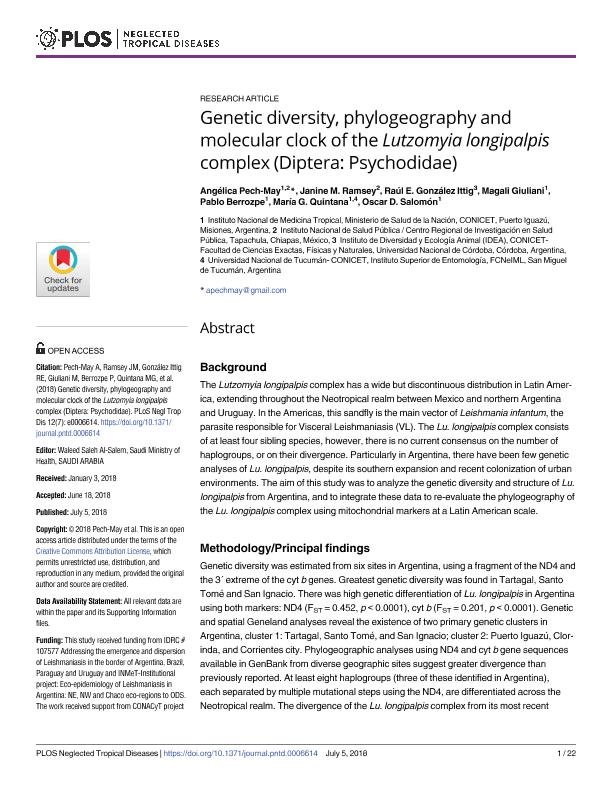Artículo
Genetic diversity, phylogeography and molecular clock of the Lutzomyia longipalpis complex (Diptera: Psychodidae)
Pech May, Angélica del Rosario ; Ramsey, Janine; González Ittig, Raúl Enrique
; Ramsey, Janine; González Ittig, Raúl Enrique ; Giuliani, Magalí Gabriela; Berrozpe, Pablo Eduardo
; Giuliani, Magalí Gabriela; Berrozpe, Pablo Eduardo ; Quintana, María Gabriela
; Quintana, María Gabriela ; Salomón, Oscar Daniel
; Salomón, Oscar Daniel
 ; Ramsey, Janine; González Ittig, Raúl Enrique
; Ramsey, Janine; González Ittig, Raúl Enrique ; Giuliani, Magalí Gabriela; Berrozpe, Pablo Eduardo
; Giuliani, Magalí Gabriela; Berrozpe, Pablo Eduardo ; Quintana, María Gabriela
; Quintana, María Gabriela ; Salomón, Oscar Daniel
; Salomón, Oscar Daniel
Fecha de publicación:
07/2018
Editorial:
Public Library of Science
Revista:
Neglected Tropical Diseases
ISSN:
1935-2727
e-ISSN:
1935-2735
Idioma:
Inglés
Tipo de recurso:
Artículo publicado
Clasificación temática:
Resumen
Background: The Lutzomyia longipalpis complex has a wide but discontinuous distribution in Latin America, extending throughout the Neotropical realm between Mexico and northern Argentina and Uruguay. In the Americas, this sandfly is the main vector of Leishmania infantum, the parasite responsible for Visceral Leishmaniasis (VL). The Lu. longipalpis complex consists of at least four sibling species, however, there is no current consensus on the number of haplogroups, or on their divergence. Particularly in Argentina, there have been few genetic analyses of Lu. longipalpis, despite its southern expansion and recent colonization of urban environments. The aim of this study was to analyze the genetic diversity and structure of Lu. longipalpis from Argentina, and to integrate these data to re-evaluate the phylogeography of the Lu. longipalpis complex using mitochondrial markers at a Latin American scale. Methodology/Principal findings: Genetic diversity was estimated from six sites in Argentina, using a fragment of the ND4 and the 3´ extreme of the cyt b genes. Greatest genetic diversity was found in Tartagal, Santo Tomé and San Ignacio. There was high genetic differentiation of Lu. longipalpis in Argentina using both markers: ND4 (FST= 0.452, p < 0.0001), cyt b (FST= 0.201, p < 0.0001). Genetic and spatial Geneland analyses reveal the existence of two primary genetic clusters in Argentina, cluster 1: Tartagal, Santo Tomé, and San Ignacio; cluster 2: Puerto Iguazú, Clorinda, and Corrientes city. Phylogeographic analyses using ND4 and cyt b gene sequences available in GenBank from diverse geographic sites suggest greater divergence than previously reported. At least eight haplogroups (three of these identified in Argentina), each separated by multiple mutational steps using the ND4, are differentiated across the Neotropical realm. The divergence of the Lu. longipalpis complex from its most recent common ancestor (MRCA) was estimated to have occurred 0.70 MYA (95% HPD interval = 0.48–0.99 MYA). Conclusions/Significance: This study provides new evidence supporting two Lu. longipalpis genetic clusters and three of the total eight haplogroups circulating in Argentina. There was a high level of phylogeographic divergence among the eight haplogroups of the Lu. longipalpis complex across the Neotropical realm. These findings suggest the need to analyze vector competence, among other parameters intrinsic to a zoonosis, according to vector haplogroup, and to consider these in the design and surveillance of vector and transmission control strategies.
Palabras clave:
Lutzomyia Longipalpis
,
Genetic diversity
,
Phylogeography
,
Molecular clock
Archivos asociados
Licencia
Identificadores
Colecciones
Articulos(CCT - NOA SUR)
Articulos de CTRO.CIENTIFICO TECNOL.CONICET - NOA SUR
Articulos de CTRO.CIENTIFICO TECNOL.CONICET - NOA SUR
Articulos(CCT - NORDESTE)
Articulos de CTRO.CIENTIFICO TECNOL.CONICET - NORDESTE
Articulos de CTRO.CIENTIFICO TECNOL.CONICET - NORDESTE
Articulos(IDEA)
Articulos de INSTITUTO DE DIVERSIDAD Y ECOLOGIA ANIMAL
Articulos de INSTITUTO DE DIVERSIDAD Y ECOLOGIA ANIMAL
Citación
Pech May, Angélica del Rosario; Ramsey, Janine; González Ittig, Raúl Enrique; Giuliani, Magalí Gabriela; Berrozpe, Pablo Eduardo; et al.; Genetic diversity, phylogeography and molecular clock of the Lutzomyia longipalpis complex (Diptera: Psychodidae); Public Library of Science; Neglected Tropical Diseases; 12; 7; 7-2018; 1-22
Compartir
Altmétricas



